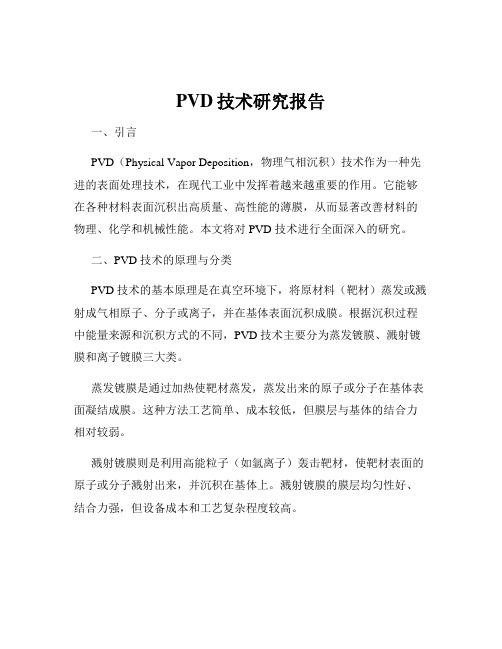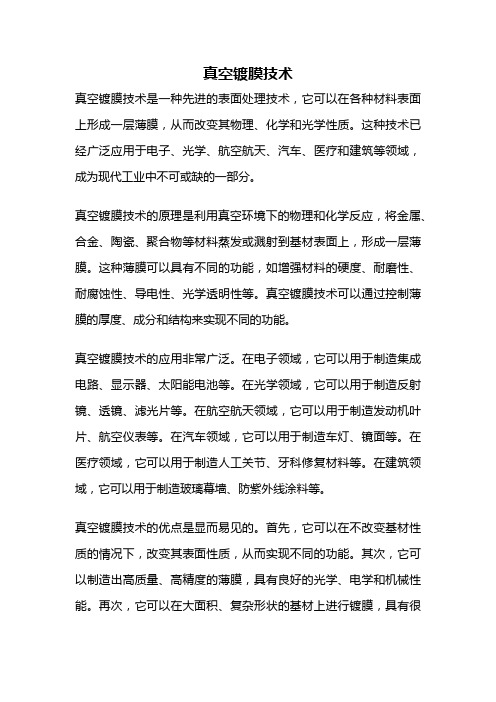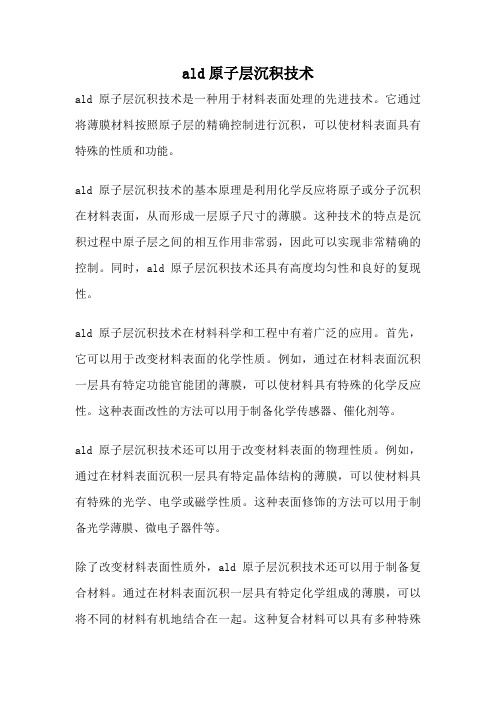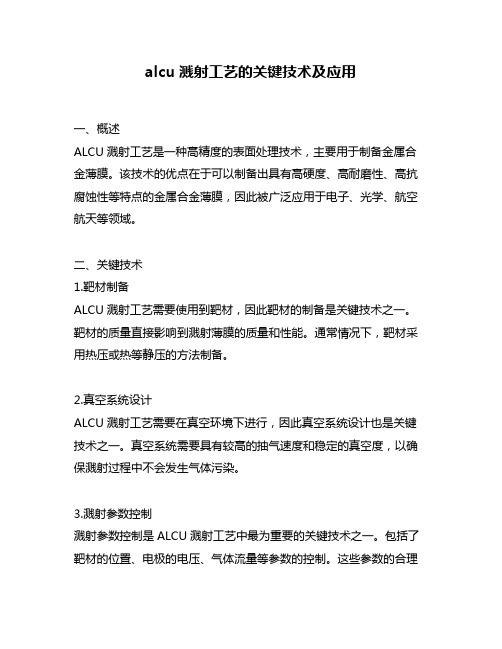薄膜表面处理技术前沿
涂层技术的发展及应用

涂层技术的发展及应用涂层技术是一种在基材表面形成一层覆盖物的制造技术。
随着科学技术的不断进步,涂层技术的发展和应用也得到了长足的进展。
下面将从涂层技术的发展趋势、应用领域和未来发展方向三个方面进行讨论。
1.薄膜涂层技术:随着纳米科技的发展,薄膜涂层技术得到了广泛应用。
薄膜涂层技术可以使基材表面具有一定的功能,如防腐、防刮擦、抗氧化等,同时还可以对基材进行改性,提高其力学性能和化学稳定性。
2.多功能涂层技术:涂层技术的发展逐渐由单一功能向多功能方向发展,如具有防水、防污、防紫外线和抗菌等多种功能于一体的复合涂层。
多功能涂层技术可以满足人们对材料性能的多样化和个性化需求。
3.环保涂层技术:随着环保意识的提高,涂层技术的环保性也受到了广泛关注。
传统的有机溶剂型涂料中含有有机溶剂,对环境和人体健康有害。
因此,发展环保涂层技术成为当前的趋势之一,如水性涂料、无溶剂涂料等,这些涂料对环境污染少,能够降低有机溶剂的排放。
1.汽车工业:涂层技术在汽车制造中扮演着重要角色。
汽车的外观涂层能够提供防腐、抗刮擦、美观等功能,同时还可以改善车辆的燃油效率。
另外,涂层技术在汽车零部件的制造中也有广泛应用。
2.建筑工业:涂层技术在建筑工业中主要应用于墙面、天花板、地板等室内外装饰材料的涂装。
这些涂料可以提高建筑物的耐候性、耐火性和美观度。
3.电子工业:涂层技术在电子工业中用于保护电子元器件和电路板。
电子元器件的涂层可以提高其防潮、防腐、绝缘和散热性能。
4.能源工业:涂层技术在能源工业中应用广泛,如太阳能电池板涂层、涂层燃料电池、涂层光伏薄膜等。
5.医疗工业:涂层技术在医疗器械、假体等医疗领域也有重要应用,如具有抗菌、生物相容性和生物降解性的医用涂层。
未来涂层技术的发展方向主要包括以下几个方面:1.纳米涂层技术:由于纳米颗粒的特殊性质,纳米涂层技术在涂层领域具有广阔的应用前景。
未来纳米涂层技术将得到更广泛的研究和应用。
2.智能涂层技术:随着智能材料的发展,涂层也将发展成为具有智能功能的材料。
薄膜技术的发展和应用

薄膜技术的发展和应用随着科技的不断进步,薄膜技术也得到了广泛应用和发展。
本文将就薄膜技术的发展和应用进行介绍。
一、薄膜技术的定义和分类薄膜技术是指将材料以极薄的层数覆盖在基材表面上的技术。
薄膜技术因其独特的性质,在电子、医疗、能源、光电和材料领域都有广泛的应用。
薄膜技术按照制备工艺可分为物理气相沉积法、化学气相沉积法、溅射法、离子束沉积法和溶液法等。
其中,物理气相沉积法和化学气相沉积法是基于气相反应制备薄膜,而溅射法和离子束沉积法则是基于固态反应制备薄膜。
二、薄膜技术的应用1、电子领域薄膜技术在电子领域有着广泛的应用,如显示器件中的膜电极和透光薄膜,硅上集成电路中的金属线薄膜和凸点薄膜,以及太阳能电池中的透明导电膜等。
通过不同种类的薄膜组合,可以制造出光电显示器件、光二极管、半导体器件等。
2、医疗领域薄膜技术在医疗领域也有广泛的应用,如人造器官表面的生物相容性薄膜、药物释放薄膜、医用传感器薄膜、隔离膜和过滤膜等。
这些薄膜可以帮助医学界实现更好的医学检测和治疗。
3、能源领域薄膜技术在能源领域也发挥了重要的作用,如太阳能电池和燃料电池中的薄膜。
通过合适的制备工艺可以制造出透明导电膜、锂离子电池隔膜、固体氧化物燃料电池氧离子传输膜等薄膜材料。
4、光电领域光电领域是薄膜技术应用较早的领域之一,尤其是光学涂层和抗反射膜方面的应用。
薄膜技术不仅可以增强光学元件的透过率和强度,还可以制造仿生光学器件等。
5、材料领域薄膜技术还可以制造出纳米微观结构,实现材料性质的精细控制,如金属膜的纳米微结构、高分子复合薄膜、磁性薄膜等,这些材料在生产制造、传感器等领域有广泛的应用。
三、薄膜技术未来的发展趋势随着技术的不断更新,薄膜技术也在不断地发展和创新。
未来薄膜技术的发展趋势将主要集中在以下几个方面:1、多层薄膜技术的发展多层薄膜技术是目前的一个研究热点,它可以实现对于薄膜性质的控制和变化。
通过不同比例的堆叠和改变各种材料的结构和性质,可以制备出更加精细的薄膜材料。
ipd薄膜工艺技术

ipd薄膜工艺技术(原创实用版)目录1.IPD 薄膜工艺技术概述2.IPD 薄膜工艺技术的应用领域3.IPD 薄膜工艺技术的优势4.IPD 薄膜工艺技术的发展前景正文一、IPD 薄膜工艺技术概述IPD 薄膜工艺技术,即等离子体增强化学气相沉积(Plasma-Enhanced Chemical Vapor Deposition,简称 PECVD)技术,是一种制造薄膜材料的先进工艺。
该技术通过等离子体与气体分子的反应,使气体分子活性增强,从而在基材表面形成高质量的薄膜。
这种技术广泛应用于各种薄膜材料的制备,如半导体、光学、功能性涂层等领域。
二、IPD 薄膜工艺技术的应用领域1.半导体产业:IPD 薄膜工艺技术在半导体产业中具有举足轻重的地位,主要用于制备硅薄膜、氧化物薄膜和低 k 材料等,这些薄膜对于提高半导体器件的性能和可靠性至关重要。
2.光学产业:在光学领域,IPD 薄膜工艺技术主要应用于制备光学薄膜,如反射膜、增透膜、偏振膜等。
这些薄膜在光学元件、显示器、照明等领域具有广泛应用。
3.功能性涂层:IPD 薄膜工艺技术还可以用于制备具有特定功能的涂层,如防腐、耐磨、抗摩擦等。
这些功能性涂层在航空、航天、汽车等产业领域具有广泛应用。
三、IPD 薄膜工艺技术的优势1.高质量薄膜:IPD 薄膜工艺技术可以制备出具有优异性能的薄膜,这些薄膜在物理、化学和电学性能方面表现出色。
2.可控性强:IPD 薄膜工艺技术具有较强的可控性,可以通过调节等离子体参数、气体成分和工艺条件等实现对薄膜性能的调控。
3.广泛应用:IPD 薄膜工艺技术具有广泛的应用领域,可满足不同产业对薄膜材料的需求。
4.低成本:与传统薄膜制备工艺相比,IPD 薄膜工艺技术具有较低的成本,有利于提高产品的经济效益。
四、IPD 薄膜工艺技术的发展前景随着科技的不断进步,IPD 薄膜工艺技术在各个领域的应用将不断拓展。
未来,该技术将继续向高效、绿色、智能化方向发展,以满足社会对薄膜材料的日益增长需求。
表面处理技术及其发展趋势

1 表 面 处 理技 术 现 状 及 国 内外 发 展 趋 势
表面改性与涂层技术作为表 面工程 的重要组成部分 , 已经渗透到 传统工业与高新技术产业部 门, 根据应用的要求反过来又促进表面功 能覆层 技术 的进一步发展 。 根据使用要求 。 对材料表面进行设计 、 对表 面性能参数进行剪裁 , 使之符合特定 要求 , 并进一步实 现对 表面覆 盖 层 的组 织 结 构 和 性 能 和 预 测 等 , 已成 为 该 领 域 重 要 研 究 方 向 。 国外 已 对 C D、 V 以及 其 它 表 面 改 性方 法 开展 计 算 机 模 拟研 究 , 对 C D V PD 针 V 过程 进行模拟 , 采用宏观和微观多层 次模 型 , 对工艺和涂层各种性 能 和基体的结合 力进行模拟和预测 ; 渗碳 , 对 渗氮工件渗层性能应力等 进行计算机模拟等等 , 人们可 以更好地控制和优化工艺过程 。我国这 方 面 的研 究 刚 处 地 超 步 阶段 。
工艺过程 的 自动控制 。加强成膜 、 膜基结合 机理 的研究 , 降低制膜温 度 , 化 反 应过 程 及 工 艺 参 数 , 成 各 种 耐磨 、 蚀 的新 优质 镀 层 。重 优 合 抗 点 解 决 国家 安 全及 支 柱 产 业 急 需 解 决 的表 面 工程 技 术 难 题 。 争 形 成 力 创 新 性 科 技 成 果 , 进 通 用机 械 、 门 、 作 模 具 、 温 模 具 等 行 业 的 促 阀 冷 高
0 引 言
新 型 表 面 功 能 覆层 技 术 . 括 低 温 化 学 表 面 涂层 技术 及 超 深层 表 包
得 突 破 性进 展 , 国 、 典 等 国 已 推 出金 刚石 金 属 切 削 工 具 供 应 市 场 , 美 瑞 而 我 国 该技 术还 没 有 达 到 实 用 水 平 , 待 开 发 并 实 现产 业 化 。 急 1 表面 改 性 与 涂 层 工 艺模 拟 和 性 能 预 测 的 现状 及 发 展 趋 势 . 5
材料科学中表面处理技术及应用前景展望

材料科学中表面处理技术及应用前景展望表面处理技术在材料科学领域中具有重要的地位和广泛的应用前景。
随着科技的不断进步和材料需求的多样化,不同表面处理技术的发展与应用也日益增多,为各行各业的材料需求提供了多种解决方案。
本文将重点介绍表面处理技术的基础知识、常见的表面处理技术和其应用前景展望。
首先,我们来了解一下表面处理技术的基本概念和原理。
表面处理技术是指对物体表面进行物理、化学或机械处理,以改变其表面性质、形态或者实现特定的功能。
表面处理技术主要通过改变材料表面的化学成分、组织结构或形貌等方式来达到预期的目的。
其基本原理是通过增加表面层的相关组成、改变材料的物理性质,从而在一定程度上改变材料整体的性能。
在表面处理技术中,最常见的方法之一是化学处理。
化学处理一般是通过在材料表面形成一层化学膜或改变材料的化学成分来实现。
例如,阳极氧化是一种常用的化学处理方法,可以在金属表面形成一层致密的氧化膜,提高金属的耐腐蚀性、耐磨性和硬度。
此外,化学镀、电镀和浸渍等方法也常用于表面处理,使材料具有一定的防腐蚀、导电、绝缘等功能。
除了化学处理,物理处理也是表面处理技术的重要手段之一。
电子束熔凝、电弧喷涂和激光熔凝等物理处理方法可以通过高能量束的作用,改变材料表面的内部结构和形貌,提高材料的硬度、强度和耐磨性。
物理气相沉积(PVD)和化学气相沉积(CVD)也是常见的物理处理方法,通过在材料表面沉积一层薄膜来改变其表面性质,如陶瓷涂层、纳米薄膜等。
随着科技的发展,表面处理技术在科学研究和工业生产中得到了广泛应用。
在航空航天领域,表面处理技术可以提高材料的抗氧化、耐热和耐高温等性能,用于制造高温合金和热防护涂层等。
在电子信息领域,表面处理技术可以制备导电性好、抗氧化和耐蚀的电子元件,如金属薄膜电阻器、集成电路和光纤等。
此外,在能源领域、环境保护领域和生物医学领域,表面处理技术也具有广阔的应用前景。
在能源领域,表面处理技术可以提高太阳能电池板的光吸收效率和光电转化效率,同时降低材料的成本和环境污染。
PVD技术研究报告

PVD技术研究报告一、引言PVD(Physical Vapor Deposition,物理气相沉积)技术作为一种先进的表面处理技术,在现代工业中发挥着越来越重要的作用。
它能够在各种材料表面沉积出高质量、高性能的薄膜,从而显著改善材料的物理、化学和机械性能。
本文将对 PVD 技术进行全面深入的研究。
二、PVD 技术的原理与分类PVD 技术的基本原理是在真空环境下,将原材料(靶材)蒸发或溅射成气相原子、分子或离子,并在基体表面沉积成膜。
根据沉积过程中能量来源和沉积方式的不同,PVD 技术主要分为蒸发镀膜、溅射镀膜和离子镀膜三大类。
蒸发镀膜是通过加热使靶材蒸发,蒸发出来的原子或分子在基体表面凝结成膜。
这种方法工艺简单、成本较低,但膜层与基体的结合力相对较弱。
溅射镀膜则是利用高能粒子(如氩离子)轰击靶材,使靶材表面的原子或分子溅射出来,并沉积在基体上。
溅射镀膜的膜层均匀性好、结合力强,但设备成本和工艺复杂程度较高。
离子镀膜是在溅射镀膜的基础上,引入了离子束辅助沉积,通过离子的轰击作用改善膜层的性能和结构。
离子镀膜具有膜层致密、硬度高、耐磨性好等优点。
三、PVD 技术的工艺流程PVD 技术的工艺流程一般包括以下几个主要步骤:1、基体预处理为了获得良好的膜基结合力和膜层质量,基体在镀膜前需要进行严格的预处理,包括清洗、除油、除锈、抛光等。
2、抽真空将镀膜室抽至一定的真空度,以减少气体分子对沉积过程的干扰。
3、加热基体根据需要,对基体进行加热,以提高膜层的沉积效率和质量。
4、沉积薄膜通过蒸发、溅射或离子镀等方式,使靶材材料沉积在基体表面形成薄膜。
5、后处理镀膜完成后,对膜层进行适当的后处理,如退火、淬火等,以改善膜层的性能。
四、PVD 技术的应用领域PVD 技术由于其独特的优势,在众多领域得到了广泛的应用。
1、刀具和模具行业通过在刀具和模具表面沉积耐磨、耐腐蚀的薄膜,如 TiN、TiCN 等,显著提高了其使用寿命和加工性能。
真空镀膜技术

真空镀膜技术真空镀膜技术是一种先进的表面处理技术,它可以在各种材料表面上形成一层薄膜,从而改变其物理、化学和光学性质。
这种技术已经广泛应用于电子、光学、航空航天、汽车、医疗和建筑等领域,成为现代工业中不可或缺的一部分。
真空镀膜技术的原理是利用真空环境下的物理和化学反应,将金属、合金、陶瓷、聚合物等材料蒸发或溅射到基材表面上,形成一层薄膜。
这种薄膜可以具有不同的功能,如增强材料的硬度、耐磨性、耐腐蚀性、导电性、光学透明性等。
真空镀膜技术可以通过控制薄膜的厚度、成分和结构来实现不同的功能。
真空镀膜技术的应用非常广泛。
在电子领域,它可以用于制造集成电路、显示器、太阳能电池等。
在光学领域,它可以用于制造反射镜、透镜、滤光片等。
在航空航天领域,它可以用于制造发动机叶片、航空仪表等。
在汽车领域,它可以用于制造车灯、镜面等。
在医疗领域,它可以用于制造人工关节、牙科修复材料等。
在建筑领域,它可以用于制造玻璃幕墙、防紫外线涂料等。
真空镀膜技术的优点是显而易见的。
首先,它可以在不改变基材性质的情况下,改变其表面性质,从而实现不同的功能。
其次,它可以制造出高质量、高精度的薄膜,具有良好的光学、电学和机械性能。
再次,它可以在大面积、复杂形状的基材上进行镀膜,具有很高的生产效率。
最后,它可以使用多种材料进行镀膜,具有很高的灵活性和适应性。
当然,真空镀膜技术也存在一些挑战和限制。
首先,它需要高昂的设备和技术投入,成本较高。
其次,它对基材表面的处理要求较高,需要进行清洗、抛光等处理,否则会影响薄膜的质量。
再次,它对环境的要求较高,需要在无尘、无湿、无氧的环境下进行。
最后,它的应用范围受到材料的限制,某些材料不适合进行真空镀膜。
总的来说,真空镀膜技术是一种非常重要的表面处理技术,具有广泛的应用前景。
随着科技的不断进步和应用领域的不断扩展,真空镀膜技术将会得到更加广泛的应用和发展。
磁控溅射镀膜技术的研究进展

磁控溅射镀膜技术的研究进展磁控溅射镀膜技术是一种常见的表面处理技术,它可以在各种基材表面制备出具有特殊性能的薄膜层。
随着技术的不断发展,在材料的选择、制备工艺、表面状态分析等方面都有所进步,使得磁控溅射镀膜技术在科学研究和实际应用中发挥着重要作用。
一、磁控溅射镀膜技术的基本原理磁控溅射镀膜技术基于靶材发射金属离子的原理,通过高能离子轰击固体靶材表面,使得金属离子从靶材表面脱离并沉积在基材表面上,从而形成具有一定厚度和化学组成的功能性膜层。
这种技术的独特之处在于可以通过控制靶材的化学成分和溅射工艺参数来调控薄膜层的结构和性能。
其中,靶材的化学成分直接影响薄膜层的组成,而溅射工艺参数如气压、功率、溅射气体种类和气体流量等则直接影响溅射速率和膜层的质量。
二、材料选择与制备工艺磁控溅射镀膜技术广泛用于各种材料的制备,包括金属、合金、氧化物、硅类材料以及半导体材料等。
对于不同的材料,其制备工艺也有所不同。
金属材料通常采用单一金属靶材或合金靶材进行制备,而合金靶材的组成比例可以通过调整靶材的制备工艺来实现。
氧化物材料则需要先将靶材还原成金属或合金形态,然后利用气氛调节技术调节气氛中氧气含量来制备氧化物膜层。
在制备工艺方面,需要进行适当的气氛调节和工艺优化。
例如,在制备合金材料时,需要考虑合金靶材的制备过程中的变形问题,找到合适的制备参数来保证靶材的均匀溅射和膜层的均匀沉积。
三、表面状态分析磁控溅射镀膜技术制备出的膜层常常需要通过表面状态分析来控制其性能,最常用的分析方法是X射线衍射和扫描电镜技术。
X射线衍射技术可以用于分析膜层的结晶性、晶格参数和晶胞结构等信息,从而定量描述膜层的结构和性能。
而扫描电镜技术则可以提供更丰富和直观的表面形貌信息,包括表面粗糙度、形貌变化和结构特征等。
此外,还有一些其他的表面分析技术如原子力显微镜、能量散射光谱和X射线光电子能谱等,可以用于全面分析膜层的属性和性能。
四、应用前景磁控溅射镀膜技术在各种领域都得到了广泛应用,在新能源、医疗、航空航天等高科技产业中有着重要的地位。
薄膜与涂层现代表面技术

材料表面技术分类材料表面技术:材料表而涂镀技术、材料表而改性技术、材料表而微细加工技术、表而检测分析与质量评估。
材料表面涂镀技术:物理气相沉积PVD、化学气相沉积CVD、电镀及阳极氧化、化学镀、热喷涂喷焊、电刷镀、电泳涂层、涂镀(喷塑油漆)、表而复合处理技术、材料纳米化表面工程技术。
材料表而改性技术:活性气体离子处理、气体扩渗、液体扩渗、固体扩渗、机械强化、激光表而处理、电子束表而改性、离子朿表面改性。
材料表面微细加工技术:光刻加工、电子束微细加工、离子朿微细加工、激光朿微细加工、微细电火花加工、微细喷粉加工、超声波加工、微细电解加工、微电铸加工、LIGA技术加工。
表而检测分析与质量评估:表面分析技术、表而物化特性、表而几何特性、表而力学特性、质呈:标准与质量评估。
表而工程学现代材料表而工程学:材料表而工程基础理论、材料表而工程技术、材料表而检测技术、材料表而工程技术设计、材料表面工程应用。
材料表面工程基础理论:腐蚀与防护理论,表而磨擦*1磨损理论,表而完整性与界面理论,表而物理化学,表而装饰与美学,表而机、力、热、光、声、电、磁等功能膜层设计理论,表面功能特性间耦合转换、复合性能理论,表而失效理论及其分析理论,低维材料的结构理论。
材料表面工程技术:材料表面改性技术、薄膜技术、涂层技术、材料表而复合处理技术、材料表而纳米化工程技术。
材料表面改性技术:表面形变强化,表而相变强化,表而扩散渗入,化学转化,电化学转化,等离子表而强化,藹子朿、电子朿、激光朿表面改性。
薄膜技术:光学薄膜沉积技术,电子学薄膜沉积技术,光电子薄膜沉积技术,集成光学薄膜沉积技术,传感器用薄膜沉积技术,金刚石薄膜(含类金刚石薄膜)沉积技术,防护用(耐蚀、耐磨、抗高温氧化、防潮、髙强高硬、装饰等)薄膜沉积技术。
涂层技术:热喷涂技术、电化学沉积技术、有机涂层技术、无机涂层技术、热浸镀技术、防锈技术。
材料表面复合处理技术:镀覆层一一热处理,表而热处理一一表而化学处理,热处理一—表面形变强化,镀膜一一注入一一扩渗,离子注入一一镀膜,激光一一气相沉积,电子束——气相沉积,等离子喷涂一一激光。
ald原子层沉积技术

ald原子层沉积技术ald原子层沉积技术是一种用于材料表面处理的先进技术。
它通过将薄膜材料按照原子层的精确控制进行沉积,可以使材料表面具有特殊的性质和功能。
ald原子层沉积技术的基本原理是利用化学反应将原子或分子沉积在材料表面,从而形成一层原子尺寸的薄膜。
这种技术的特点是沉积过程中原子层之间的相互作用非常弱,因此可以实现非常精确的控制。
同时,ald原子层沉积技术还具有高度均匀性和良好的复现性。
ald原子层沉积技术在材料科学和工程中有着广泛的应用。
首先,它可以用于改变材料表面的化学性质。
例如,通过在材料表面沉积一层具有特定功能官能团的薄膜,可以使材料具有特殊的化学反应性。
这种表面改性的方法可以用于制备化学传感器、催化剂等。
ald原子层沉积技术还可以用于改变材料表面的物理性质。
例如,通过在材料表面沉积一层具有特定晶体结构的薄膜,可以使材料具有特殊的光学、电学或磁学性质。
这种表面修饰的方法可以用于制备光学薄膜、微电子器件等。
除了改变材料表面性质外,ald原子层沉积技术还可以用于制备复合材料。
通过在材料表面沉积一层具有特定化学组成的薄膜,可以将不同的材料有机地结合在一起。
这种复合材料可以具有多种特殊性质,例如高强度、高导电性等。
ald原子层沉积技术的发展离不开先进的设备和精确的控制方法。
目前,已经开发出了多种ald设备,可以实现对不同材料的原子层沉积。
同时,还发展了一系列用于监测和控制ald沉积过程的方法,以确保沉积薄膜的质量和性能。
然而,ald原子层沉积技术仍然面临一些挑战。
首先,ald沉积速度较慢,制备一层薄膜需要较长时间。
其次,ald沉积过程中需要高度精确的控制,对设备和操作人员的要求较高。
此外,ald技术在某些材料上的应用还存在一定的限制。
ald原子层沉积技术是一种非常有前景的材料表面处理技术。
它可以实现对材料表面性质的精确控制,具有广泛的应用潜力。
随着设备和方法的进一步发展,ald原子层沉积技术将在材料科学和工程领域发挥更大的作用。
2023年表面处理行业未来发展趋势

表面处理行业未来发展趋势2022即将过去,2022就要来到,在这个除旧迎新的日子里,表面处理行业在这一年经受了许多,也度过了许多,慧聪我就带您来解析在将来的2022年表面处理行业的进展趋势将会如何,是高走还是低开,让我渐渐道来:传统的表面技术,随着科学技术的进步而不断创新。
在电弧喷涂方面,进展了高速电弧喷涂,使喷涂质量大大提高。
在等离子喷涂方面,已讨论出射频感应藕合式等离子喷涂、反应等离子喷涂、用三阴极枪等离子喷枪喷涂及微等离子喷涂。
在电刷镀方面讨论出摩擦电喷镀及复合电刷镀技术。
在涂装技术方面开发出了粉末涂料技术。
在粘结技术方面,开发了高性能环保型粘结技术、纳米胶粘结技术、微胶囊技术。
在高能束应用方面进展了激光或电子束表面熔覆、表面淬火、表面合金化、表面熔凝等技术。
在离子注入方面,继强流氮离子注入技术之后,又讨论出强流金属离子注入技术和金属等离子体浸没注入技术。
在解决产品表面工程问题时,新兴的表面技术与传统的表面技术相互补充,为表面工程工供应了宽广的选择余地。
现状及国内外进展趋势随着基础工业及高新技术产品的进展,对优质、高效表面改性及涂层技术的需求向纵深延长,国内外在该领域与相关学科相互促进的局势下,在诸如"热化学表面改性"、"高能等离子体表面涂层"、"金刚石薄膜涂层技术"以及"表面改性与涂层工艺模拟和性能猜测"等方面都有着突破的进展。
热化学表面改性技术现状及进展趋势国外近年来重视对可控气氛条件和真空条件下的渗碳,碳氮共渗等技术的讨论,并已实现工业化。
而在我国应用很少,相关的技术讨论工作亦不够。
可控气氛渗碳和真空渗碳技术是显著缩短生产周期,节能、省时,同时可提高工件质量,不氧化、不脱碳,保证零件表面耐腐蚀和抗疲惫性,并削减热处理后机加工余量及清理工时。
目前国际上碳势掌握和监测,渗层布型掌握等方面的讨论成果已应用于实际生产,并用计算机进行在线动态掌握。
光学薄膜技术的最新进展

光学薄膜技术的最新进展光学薄膜技术是一门涉及光学、物理、材料科学等多个领域的交叉学科,近年来随着科技的不断发展,光学薄膜技术也取得了许多重要的突破和进展。
本文将就光学薄膜技术的最新进展进行探讨,介绍一些新的技术和应用,展望未来的发展方向。
一、多功能光学薄膜材料的研究随着人们对光学器件性能要求的不断提高,传统的光学薄膜材料已经不能完全满足需求。
因此,研究人员开始着手开发具有多功能性能的光学薄膜材料。
这些材料不仅具有优异的光学性能,还具备其他特殊功能,如抗污染、抗划伤、防紫外线等。
通过在材料表面引入特殊的功能性分子或纳米结构,可以赋予光学薄膜材料更多的特性,提高其在实际应用中的稳定性和耐用性。
二、纳米光学薄膜的制备技术纳米技术的发展为光学薄膜技术带来了新的机遇。
利用纳米技术制备的纳米光学薄膜具有更高的光学性能和更广泛的应用领域。
通过控制纳米结构的形貌和尺寸,可以调控光学薄膜的光学性质,实现对光的吸收、透射和反射的精确控制。
同时,纳米光学薄膜还具有更好的光学均匀性和稳定性,能够有效减小光学器件的色散和损耗,提高其性能和可靠性。
三、光学薄膜在光学器件中的应用光学薄膜在光学器件中有着广泛的应用,如反射镜、透镜、滤光片等。
随着光学器件对性能要求的不断提高,光学薄膜技术也在不断创新和发展。
近年来,一些新型光学器件如光子晶体、纳米光栅等开始受到关注,这些器件对光学薄膜的性能和稳定性提出了更高的要求。
因此,研究人员在光学薄膜的制备工艺、材料选择和性能优化方面进行了大量的研究,取得了许多重要的成果。
四、光学薄膜技术在光通信领域的应用光通信作为一种高速、大容量的通信方式,对光学器件的性能要求极高。
光学薄膜技术在光通信领域有着重要的应用,如光纤通信、激光器、光学放大器等。
近年来,随着5G通信的快速发展,光通信技术也得到了迅速推广,对光学薄膜技术提出了更高的要求。
研究人员通过优化光学薄膜的设计和制备工艺,提高其在光通信器件中的性能和可靠性,推动了光通信技术的进步和发展。
alcu溅射工艺的关键技术及应用

alcu溅射工艺的关键技术及应用一、概述ALCU溅射工艺是一种高精度的表面处理技术,主要用于制备金属合金薄膜。
该技术的优点在于可以制备出具有高硬度、高耐磨性、高抗腐蚀性等特点的金属合金薄膜,因此被广泛应用于电子、光学、航空航天等领域。
二、关键技术1.靶材制备ALCU溅射工艺需要使用到靶材,因此靶材的制备是关键技术之一。
靶材的质量直接影响到溅射薄膜的质量和性能。
通常情况下,靶材采用热压或热等静压的方法制备。
2.真空系统设计ALCU溅射工艺需要在真空环境下进行,因此真空系统设计也是关键技术之一。
真空系统需要具有较高的抽气速度和稳定的真空度,以确保溅射过程中不会发生气体污染。
3.溅射参数控制溅射参数控制是ALCU溅射工艺中最为重要的关键技术之一。
包括了靶材的位置、电极的电压、气体流量等参数的控制。
这些参数的合理控制可以帮助提高溅射薄膜的质量和性能。
4.后处理ALCU溅射工艺制备出来的薄膜需要进行后处理,以进一步提高其性能。
通常情况下,后处理包括退火、氧化等步骤。
三、应用1.电子领域ALCU溅射工艺可以用于制备金属合金薄膜,这些金属合金薄膜可以被应用于电子领域中。
例如,可以将其用于制作集成电路中的导线和连接器等部件。
2.光学领域ALCU溅射工艺也可以用于光学领域中。
例如,可以将其用于制备反射镜和透镜等光学元件。
3.航空航天领域ALCU溅射工艺还可以被应用于航空航天领域中。
例如,可以将其用于制备飞行器表面涂层以提高其耐磨性和抗腐蚀性等性能。
总之,ALCU溅射工艺是一种非常有前途的表面处理技术,其应用范围非常广泛。
在未来的发展中,相信该技术会得到更加广泛的应用和推广。
锡箔、薄膜、涂装表面等离子处理

铝箔、薄膜等离子高效清洁处理技术用于清洁和活化素材的等离子处理机北京震普电子设备有限公司的等离子表面处理技术可以非常便捷而又环保的对铝表面进行清洗。
复合薄膜常因其所具有的阻隔性而用于饮料或食品的包装。
在复合薄膜的加工过程中,铝箔被用来作为复合的阻隔层,需要在铝箔上复合一层PE膜,以确保铝箔不与包装中的食品直接接触。
在薄膜复合设备里,铝箔经过等离子处理,使它能够与PE膜紧密的复合在一起。
等离子体中的能量,将诸如灰尘、油污之类的各种污染物质从铝箔表面清除。
而且等离子处理工艺能够完全实现“在线”处理的方式。
在实际生产中,也有用户采用“退火”的工艺实现上述效果,但其和等离子相比,耗时又耗能等离子表面处理技术进行预处理的优点和特性:1、具有完全的“在线”集成能力(不干扰原有的工艺运行)节能、低成本、环保;2、不会改变铝箔的机械特性;3、可实现选择性的、局部清洗;4、可对铝箔进行双面处理;5、处理工序可以集成在卷绕装置前;涂装表面等离子预处理技术提高工艺品质等离子表面预处理提高涂装品质等离子系统的核心部件是等离子喷枪及等离子发生器。
在等离子喷枪内通过高压放电产生等离子体,通过气流沿着放电路径将等离子体聚集,并将其通过喷枪头导向需要处理的材料表面。
喷枪将等离子流带电的电弧局限在喷嘴内,同时决定着等离子束的几何形态。
对许多公司的涂装工序而言,环保的水性涂装工艺是其生产的核心环节,等离子预处理工艺的应用使水性涂装工艺成为可能。
它能够清除表面的油污、灰尘,并赋予材料更高的表面能量。
等离子预处理技术的清洁效应除去了表面油污,及静电作用除去了附着在表面的灰尘颗粒,而化学反应效应又提高了表面能量,这些方面的综合作用使得等离子预处理工艺成为一种高效的工具,在一般情况下,经过等离子预处理就无需额外的清洗工序和底涂处理。
塑料表面通常是化学惰性的,因为其聚合物分子链较长而表面张力很小,不含有或只有很少的活性官能团。
它们很难被粘接、涂装或者镀层。
电晕处理机薄膜表面处理机

电晕处理机薄膜表面处理机
摘要
电晕处理机薄膜表面处理机是一种用于薄膜表面处理的设备,通过电晕技术实
现对膜表面的处理,广泛应用于各种领域。
本文将介绍电晕处理机的工作原理、应用领域以及未来发展方向。
工作原理
电晕处理机薄膜表面处理机利用电场作用下带电极和非带电极之间的击穿放电
现象,使得活性离子和自由基等活性物种在电场作用下附着到薄膜表面,从而改变膜的表面性质。
这种表面处理技术可实现对薄膜表面的清洁、去除有害物质、增加表面粗糙度等效果,从而提高膜的功能性和性能。
应用领域
电晕处理机薄膜表面处理机在各个领域均有广泛应用。
在光伏行业,可用于提
高太阳能电池的光吸收率和光电转换效率;在医疗领域,可用于改善医用薄膜的表面性能,降低感染风险;在食品包装行业,可用于提高包装薄膜的气体屏障性能,延长食品的保鲜期等。
未来发展
随着科技的不断进步,电晕处理机薄膜表面处理机将会在更多领域得到应用。
未来的发展方向主要包括: - 提高处理效率和质量,减少能耗和设备成本; - 拓展
应用范围,适用于更多材料和工艺需求; - 结合其他表面处理技术,创新处理方式,提高膜的性能和稳定性。
结论
电晕处理机薄膜表面处理机是一种重要的表面处理设备,具有广泛的应用前景。
随着技术的不断创新和完善,相信在未来会有更多的发展机遇和挑战等着我们去探索和应对。
pet薄膜镀铜工艺

pet薄膜镀铜工艺Pet薄膜镀铜工艺引言:Pet薄膜镀铜工艺是一种将铜层镀覆在Pet薄膜表面的技术,以提高其导电性和阻隔性能。
本文将详细介绍该工艺的原理、步骤和应用领域。
一、工艺原理Pet薄膜镀铜工艺的原理是通过将铜材料在Pet薄膜表面沉积,形成一层导电铜层。
这样可以提高Pet薄膜的导电性能,使其可以在电子领域得到广泛应用。
同时,镀铜层还可以提高Pet薄膜的阻隔性能,使其在包装和保护材料方面有更好的性能。
二、工艺步骤1. 表面处理:首先,需要对Pet薄膜进行表面处理,以提高铜层的附着力。
常见的表面处理方法有物理处理和化学处理两种。
物理处理可以采用喷砂、打磨等方法,而化学处理可以采用酸洗、碱洗等方法。
2. 导电层沉积:在表面处理后,需要将导电材料沉积在Pet薄膜表面。
常见的导电材料有铜、铝等。
其中,镀铜是最常用的方法。
镀铜液中含有铜离子,通过电解的方式将铜离子还原成金属铜,从而形成导电铜层。
3. 防护层涂覆:为了保护镀铜层,常常需要在其表面涂覆一层防护层。
防护层可以采用涂料、胶粘剂等材料,以增强镀铜层的耐磨性和耐腐蚀性。
4. 检测和包装:最后,对镀铜膜进行质量检测,确保其符合要求。
合格的镀铜薄膜可以进一步进行包装,以便在后续的应用中使用。
三、应用领域Pet薄膜镀铜工艺在电子领域有广泛的应用。
首先,镀铜薄膜可以作为柔性电路板的基板,用于连接各种电子元件。
其柔性和导电性能使得柔性电路板可以应用于智能手机、平板电脑等移动设备中。
其次,镀铜薄膜还可以作为电磁屏蔽材料,用于减少电子设备之间的干扰。
此外,镀铜薄膜还可以作为太阳能电池的电极材料,提高电池的光电转换效率。
结论:Pet薄膜镀铜工艺是一种重要的技术,通过在Pet薄膜表面镀铜,可以提高其导电性和阻隔性能。
该工艺在电子领域有广泛的应用,如柔性电路板、电磁屏蔽材料和太阳能电池等。
随着电子行业的快速发展,Pet薄膜镀铜工艺将会得到更广泛的应用和发展。
pvd真空镀膜技术

pvd真空镀膜技术PVD真空镀膜技术是一种先进的表面处理技术,可以在各种材料表面形成均匀、致密的薄膜。
它在许多领域都有广泛的应用,如光学、电子、汽车、航空航天等行业。
这项技术不仅能提高材料的表面硬度和耐磨性,还能改善材料的光学性能和化学稳定性。
PVD真空镀膜技术基于真空环境下的物理过程,通过在材料表面蒸发、溅射或离子轰击等方式,将金属或非金属材料沉积在基材上,形成一层均匀、致密的薄膜。
这种薄膜可以具有不同的功能和特性,如反射、透明、防腐、导电、隔热等,可根据不同的需求进行调控。
PVD真空镀膜技术具有许多优点。
首先,它能够在较低的温度下进行,不会对基材产生热应力,保持了材料的原始性能。
其次,由于在真空环境下进行,可以有效避免氧化、污染等问题,使得薄膜的质量更高。
此外,PVD技术还能够实现对薄膜成分和结构的精确控制,从而满足不同行业对薄膜的特定要求。
在光学领域,PVD真空镀膜技术广泛应用于镜片、滤光片等光学元件的制造。
通过在玻璃或塑料表面镀膜,可以提高透过率、降低反射率,实现更清晰、明亮的视觉效果。
同时,PVD技术还可以增加镜片的硬度和耐刮性,提高其使用寿命。
在电子领域,PVD真空镀膜技术被广泛应用于集成电路、显示器、太阳能电池等器件的制造。
通过在电子器件表面镀膜,可以提高其导电性能、耐蚀性和稳定性,增加其工作寿命。
此外,PVD技术还可以制备纳米级别的薄膜材料,用于制造新型电子器件,如纳米传感器、量子点器件等。
在汽车和航空航天领域,PVD真空镀膜技术被广泛用于改善材料的耐腐蚀性和耐磨性。
通过在汽车零部件表面镀膜,可以提高其抗氧化能力和耐候性,延长使用寿命。
同时,PVD技术还可以制备具有低摩擦系数和高硬度的薄膜,用于减少摩擦损失和提高燃油效率。
PVD真空镀膜技术是一项重要的表面处理技术,具有广泛的应用前景。
它不仅能够改善材料的性能和功能,还能提高产品的质量和竞争力。
随着科技的不断进步,PVD技术将在更多领域发挥重要作用,推动材料科学和工程的发展。
- 1、下载文档前请自行甄别文档内容的完整性,平台不提供额外的编辑、内容补充、找答案等附加服务。
- 2、"仅部分预览"的文档,不可在线预览部分如存在完整性等问题,可反馈申请退款(可完整预览的文档不适用该条件!)。
- 3、如文档侵犯您的权益,请联系客服反馈,我们会尽快为您处理(人工客服工作时间:9:00-18:30)。
Surface Treatment(Contributed by The ChemQuest Group)IntroductionFor effective bonding, the adhesive must completely wet the surface of each substrate being joined together. In addition, strong attractive interactions must form between the adhesive and the substrates. To satisfy these conditions, the surface of the substrate must be clean, reasonably smooth, and chemically receptive to the chosen adhesive. Surface treatment is the process whereby the adherend surface is cleaned and/or chemically treated to promote better adhesion.To a large extent the surface treatment determines how well and for how long a bond will hold, Figure 1. If the chosen adhesive can withstand the service conditions to which the bond will be subjected, then the life and service expectancy of that bond will be directly proportional to the degree of surface treatmentFigure 1. The effect of surface treatment on overlap shear strength (epoxy adhesive).Since surface treatment adds another step (and additional expense) to the bonding process there is a tendency to reduce or even eliminate it all together. However, in general, the level of surface treatment used should be the minimum amount that gives a reproducible bonded part having the desired level of performance.Surface treatment promotes adhesion by making it possible for the adhesive to wet the actual surface of the substrate, rather than its apparent surface. In many cases, what appears to be the surface is, in reality, a layer of grease, dirt, oil, or some other contaminant, Figure 2. The method used to prepare such surfaces for adequate wetting willdepend on the type of contaminant and the nature of the adherend.1. Surface contamination (dust, oil,grease, …)2. Absorbed film (moisture)3. Oxide layer, e.g. rust on steel4. Actual metal,e.g. steel, aluminiumFigure 2. Typical surface layers on a metal substrate.As a general rule the adhesive should be applied immediately after the surface treatment. If this is not possible the treated surface should be protected, for example by covering with kraft paper. Avoid putting finger prints on the newly prepared surface. If the substrate is left for more than a day before applying the adhesive it may be necessary to repeat the surface treatment.Metal SurfacesContaminants that create bonding problems on metal surfaces include grease, dust, dirt, oil and oxide caused by air corrosion. Grease and oil not only interfere with bonding, but also make certain types of preparation operations, such as chemical surface modification ineffective.Whether a metal adherend requires solvent cleaning, abrasive blasting, priming, or a combination of preparation methods depends upon how strong and durable the bond must be.Wood SurfacesCommon wood contaminants include resin and wax. Wood also contains absorbed moisture that can lead to large dimensional changes. Before bonding, wood should be dried to the level of moisture content appropriate to its service use when bonded. Surface contamination should be sanded, planed, or machined away. Debris from such mechanical cleaning operations can be removed by compressed air, vacuuming or brushing, or it can be wiped away with a solvent moistened cloth.Plastic SurfacesPlastic surfaces are subject to many of the same sorts of contamination as wood and metal. In addition, components in the plastic may migrate to the surface. The basic methods of surface treatment involve solvent cleaning, abrasion and chemical surface modification. Surface modification, by chemical or physical methods is particularly important in the case of low surface energy plastics. The introduction of polar groups at the surface dramatically improves adhesion to these surfaces.Classification of Surface TreatmentFigure 3. Possible steps involved in surface treatment.Surface treatment may involve one or all of the following (Figure 3):Surface Preparation – the removal of oil, grease and other surface contaminants, i.e. cleaning.Surface Pretreatment – the use of mechanical, chemical or physical methods to remove strongly absorbed surface layers and activate the surface.Surface Post-treatment – the application of adhesion promoters or primers to improve adhesion to the adhesive and/or protect the surface.Surface PreparationSurface preparation encompasses two main types of cleaning: a) detergent, b) solvent. The choice of cleaning method used will depend upon the type of substrate (metallic ornonmetallic) and the extent and nature of contamination. In some instances, it may suffice to merely dust or blow away loose dirt. In other cases, it may be necessary to remove all foreign material from the adherend surface.Detergent CleaningDetergent, soaps, and caustic soda are the least expensive andeasiest cleaning agents to handle. Applied by spraying, scrubbing, or immersing the part in an ultrasonically agitated solution, these cleaners can remove certain kinds of dirt and oil reasonably well. However, such cleaning agents may react with certain metals. After detergent cleaning it is necessary to rinse thoroughly with water and dry.Solvent CleaningFigure 4 summarizes the ability of different solvent types at removing the most common surface contaminants.Figure 4. Cleaning and degreasing with solvents.Solvent cleaning can be accomplished by wiping with a solvent-moistened cloth (or lint-free tissue), immersion in the solvent, or by exposure to the solvent vapor.A ketone, such as methyl ethyl ketone, is generally a good solvent for cleaning metals, but it can be too aggressive for many plastics. An alcohol, such as isopropyl alcohol, is a better choice of solvent for use with plastic substrates.Solvent cleaning should precede any chemical or abrasive surface pretreatment. Abrading a surface coated with oil, grease, or a release agent will serve only to drive the contaminants further into the substrate making it even more adhesion resistant. Further, grease and oil prevent the acid etch solution from reaching the adherend surface.Surface PretreatmentFollowing the preliminary surface preparation it may be necessary to pretreat the surface using one of variety of mechanical, chemical, or physical methods.Mechanical MethodsMechanical methods involve the use of handheld sandpaper orhand cleaning tools like wire brushes and scrapers. Suchinstruments are convenient to remove rust, scale, paint, andweld splatter. But they are too slow to use on large areas.One drawback of the abrasion process is that it causes particlesof debris to accumulate on the abraded surface. These particlescome from the abrasive, the surface contaminants, and thesurface material itself. All such particles must be removed beforeadhesive is applied. This may be accomplished with a cleancloth or brush, or with filtered compressed air.After the abrasion debris has been removed, it is usual to give another solvent clean before bonding. A solvent-moistened cloth is convenient for this, but as the cloth will become contaminated during this operation, it should be renewed frequently.Mechanical cleaning also includes a number of much faster abrading methods such as sandblasting, tumbling, and abrading with power tools.Chemical MethodsIn chemical treatments that alter the surface of the adherend, the part is dipped into a chemically active solution. This solution either dissolves part of the surface or transforms it, making it more chemically active and thus more receptive to adhesive bonding.Acid etching involves immersing a metal substrate in an aqueous acid solution to remove a loose layer of oxide from its surface. The particular acid used depends upon the metal and type of oxide being treated. In many cases acid etching may provide enough surface preparation for bonding - depending, of course, upon the degree of adhesion desired. Acid etching can also be effectively used with certain plastics, for example chromic acid is used to treat polyolefins.Anodization involves the electrochemical modification of the surface. The process deposits a porous and stable oxide layer on top of the oxide layer formed after etching of the substrate.Physical MethodsThese are t echniques where the surface is cleaned and chemically modified by exposure to highly energetic charges or other ionic species. The most common methods are flame treatment, corona discharge and plasma. These pre-treatment methods have been applied to metals and, in particular, composites and plastics.Flame treatment of the substrate surface for just a few seconds withan oxygen-containing (blue) propane or acetylene gas flame leads tothe incorporation of oxygen-containing groups at the surface. Thisimproves the wetting properties and hence the adhesion. Flametreatment is used almost exclusively for polyethylene andpolypropylene substrates. The effect of the pretreatment subsideswithin a short time so that flame-treated substrates must be bondedimmediately.A corona discharge is essentially a plasma generated in air at atmospheric pressure by applying a highfrequency and highvoltage between twoelectrodes. It contains anumber of energeticspecies that can cleanand introduce polargroups, mostlyoxidation products, atthe substrate surface.The corona dischargemay also lead to crosslinking of the polymer surface. The pretreatment effects are short lived so bonding should be carried out immediately. It is used mainly for polyolefin films and is capable of high processing speeds.A plasma is usually generated in a low pressure chamber and so is best suited to batchprocessing. Commercial units of various sizes are available. Theadvantage of this method is that it allows treatment of substratesby plasmas of gasses other than oxygen, for example argon,ammonia, or nitrogen. Plasmas created from inert gases aregenerally used to clean substrate surfaces.Surface Post-TreatmentIt may be necessary to further treat the substrate surface following surface pretreatment by theapplication of a primer or adhesion promoter. These are materials that are adsorbed strongly onto the substrate surface and that also interact strongly with the adhesive. A primer or adhesionpromoter is applied to achieve one or more of the following:Modify the surface energy of the substrate.Promote chemical reaction between adhesive and substrate.Activate the adhesive.Inhibit corrosion of the substrate.Protect the surface after pretreatment.Organo-functional silanes, for example 3-aminopropyl trimethoxysilane, are widely used to improve adhesion. The silane substituent at one end reacts with hydroxyl groups on the surface to give a polysiloxane polymeric layer. The organic substituent on the other end reacts with the adhesive providing a covalent link.Proprietary Surface TreatmentsIn recent years a number of proprietary surface treatments have been introduced that combine both physical and chemical treatments.Silicoater TM This method has been mainly used with dental alloys, to improve adhesion to other materials. The sandblasted alloy is passed through an oxidizing flame into which a solution of tetraethoxysilane is injected. This results in a layer of silica embedded in the surface of the alloy. After cooling the surface is then treated with a solution of anorganosilane coupling agent. The functionalized alloy surface is ready for adhesive bonding.ATmaP TM This method is suggested for use with a variety of materials such as plastics, glass and metals. The surface to be treated is passed through a flame with a controlled amount of oxygen into which a solution of a diamine is injected. The vaporized solutionproduces a number of reactive species in the flame that impinge on the surface resulting in hydroxyl, carboxyl, and nitrogen species being chemically bonded to the surface. Thefunctionalized surface enhances adhesion, immediately after treatment, or, after storage for several months.Rocatec TM This is a tribochemical method for functionalizing surfaces that has been used mainly for dental applications. The part to be treated is first cleaned then blasted with aluminum oxide that has been treated with a surface layer of silica. After impact some of the silica is embedded in the surface. The surface is then treated with a solution of an organosilane coupling agent to give a functionalized surface ready for adhesive bonding.O O O OSi O Si O Si O Si NH 2NH 2NH 2NH 2Surface Treatment in PracticeSome level of surface treatment is usually necessary before adhesive bonding.Although a simple solvent wipe may be sufficient for some applications, the following basic surface treatment is generally found suitable for most materials. A silane coupling agent may be used to improve surface wetting and increase the bonded joint's long-term durability.Basic Surface Treatment1.Solvent wipe to remove oil or grease contamination.2.Abrade or shot blast using medium grit (120 - 200 grit size) preferably alumina.3.Remove coarse debris, if present.4.Solvent wipe to Remove fine debris.5.Ensure surface is completely dry.6.Bond or prime immediately.Additional Chemical PretreatmentsFor some applications it may be necessary to follow the basic surface treatment with an addition pretreatment in order to achieve the level of performance required of the adhesively bonded joint. The following tables summarize chemical pretreatments for specific metals and plastics.Table 1. Chemical Pretreatments for Metalsthe surface treatment. RT = room temperature.Table 2. Chemical Pretreatments for PlasticsPhysical pretreatment (flame, corona, plasma) are also effective on most plastics. RT=room temperature.。
